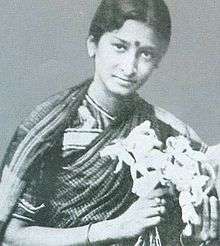Kamlabai Gokhale
| Kamalabai Gokhle | |
|---|---|
 |
Kamlabai Gokhale, born Kamlabai Kamath, was the first actress of Indian cinema, along with her mother Durgabai Kamat.[1]
Personal life
She was the daughter of Durgabai Kamat, who was the first female actress of Indian cinema and Anand Nanoskar, a professor of history at the J.J. School of Art . She married Raghunathrao Gokhale and had three children, Chandrakant Gokhale, Lalji Gokhale and Suryakant Gokhale. Chandrakant Gokhale is one of them, who is the father of Vikram Gokhale (occasionally credited as Vikram Gokhle) is well known Indian film, television and stage actor. Lalji Gokhale and Suryakant Gokhale were acclaimed Tabala maestros. Kamlabai was 25 when she became a widow, pregnant with her third child.
Career
Her first stage appearance was at the age of four. Around 1912-1913 Dadasaheb Phalke, the pioneering film-maker of India, was casting for his film Mohini Bhasmasur and he choose Kamlabai for the lead.[2] Durgabai was Parvati. Phalke had been forced to use a young male cook, Salunke, to play the female lead in his earlier film, Raja Harishchandra, for lack of an actress. By the time she was 15, Kamlabai had become a celebrity. The following year she married Raghunathrao Gokhale. He had been with the Kirloskar Natak Company where he usually performed female roles. But his voice was breaking and so he moved to his brother’s company, which was the same one where Kamlabai and her mother were employed. The young couple was cast as the new lead pair of the company. In the 1930s, Kamlabai worked under Veer Savarkar in the play Ushaap, which focussed on the plight of Harijans.[3] Kamalabai worked in around 35 movies. Her last film was Gehrayee (1980).
Filmography
- 1980 Gehrayee
- 1972 Ek Nazar
- 1971 Hulchul
- 1967 Balyakalasakhi
- 1954 Nastik Kamla
- 1952 Aladdin Aur Jadui Chirag
- 1949 Navajeevanam Kamala
- 1946 Haqdar
- 1946 Sona Chandi
- 1944 Stunt King
- 1939 Garib Ka Lal
- 1938 Chabukwali
- 1938 Street Singer (as Miss Kamala)
- 1936 Aakhri Galti
- 1936 Be Kharab Jan
- 1936 Prabhu Ka Pyara
- 1935 Barrister’s Wife
- 1935 Bikhare Moti
- 1934 Afghan Abla
- 1934 Ambarish
- 1934 Gunsundari Sushila
- 1933 Aurat Ka Dil
- 1933 Bhola Shikar
- 1933 Bhool Bhulaiyan
- 1933 Chandrahasa
- 1933 Krishna Sudama
- 1933 Lal-e-Yaman Lalarukh
- 1933 Mirza Sahiban
- 1933 Rajrani Meera
- 1932 Bhutio Mahal
- 1932 Char Chakram
- 1932 Niti Vijay
- 1932 Sheil Bala
- 1931 Devi Devayani Sharmistha (as Miss Kamala)
- 1913 Mohini Bhasmasur
References
- ↑ "Entertainment Bureau | Kamala Bai Gokhale | First Indian actress". Entertainmentbureau.in. 2012-06-07. Retrieved 2012-09-30.
- ↑ "History of Indian Cinema". Cinemaofmalayalam.net. 1913-04-21. Retrieved 2012-09-30.
- ↑ "First Lady Of The Silver Screen-Struggle, Survival And Success". Indiaprofile.com. Retrieved 2012-08-20.